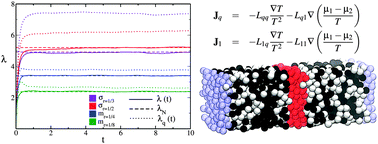Thermal conductivity of highly asymmetric binary mixtures: how important are heat/mass coupling effects?
Abstract
The coupling of mass and heat fluxes is responsible for the Soret effect in fluid mixtures containing particles of dissimilar mass and/or size. We investigate using equilibrium and non-equilibrium molecular dynamics simulations the relevance of these coupling effects in determining the thermal transport in fluids consisting of binary mixtures where the individual components feature significant mass, 1 : 8, or size, 1 : 3, asymmetries. We quantify the thermal transport by using both boundary driven molecular dynamics simulations (NEMD) and the equilibrium Green–Kubo (GK) approach and investigate the impact of different heat flux definitions, relevant in kinetic theory and experiments, in the quantification of the thermal conductivity. We find that the thermal conductivities obtained from the different definitions agree within numerical accuracy, suggesting that the Soret coefficient does not lead to significant changes in the thermal conduction, even for the large asymmetries considered here, which lead to significant Soret coefficients (∼10−2 K−1). The asymmetry in size and mass introduces large differences in the specific enthalpy of the individual components that must be carefully considered to compute accurate thermal conductivities using the GK approach. Neglecting the enthalpic contributions, results in large overestimations of the thermal conductivity, typically between 20% and 50%. Further, we quantify the time dependent behavior of the internal energy and mass flux correlation functions and propose a microscopic mechanism for the heat transport in these asymmetric mixtures.


 Please wait while we load your content...
Please wait while we load your content...